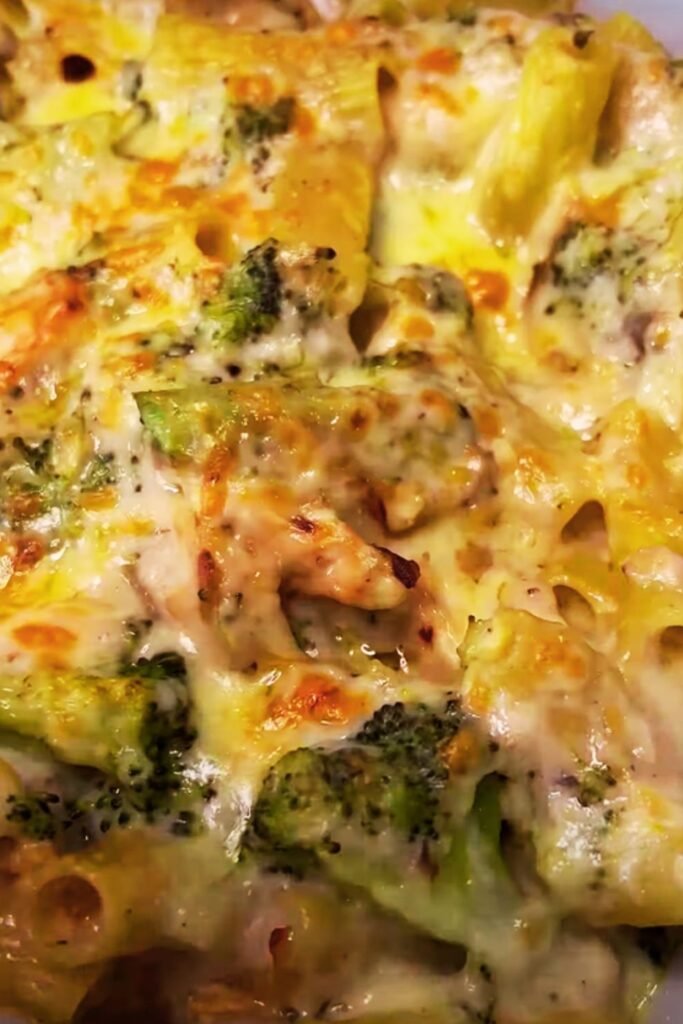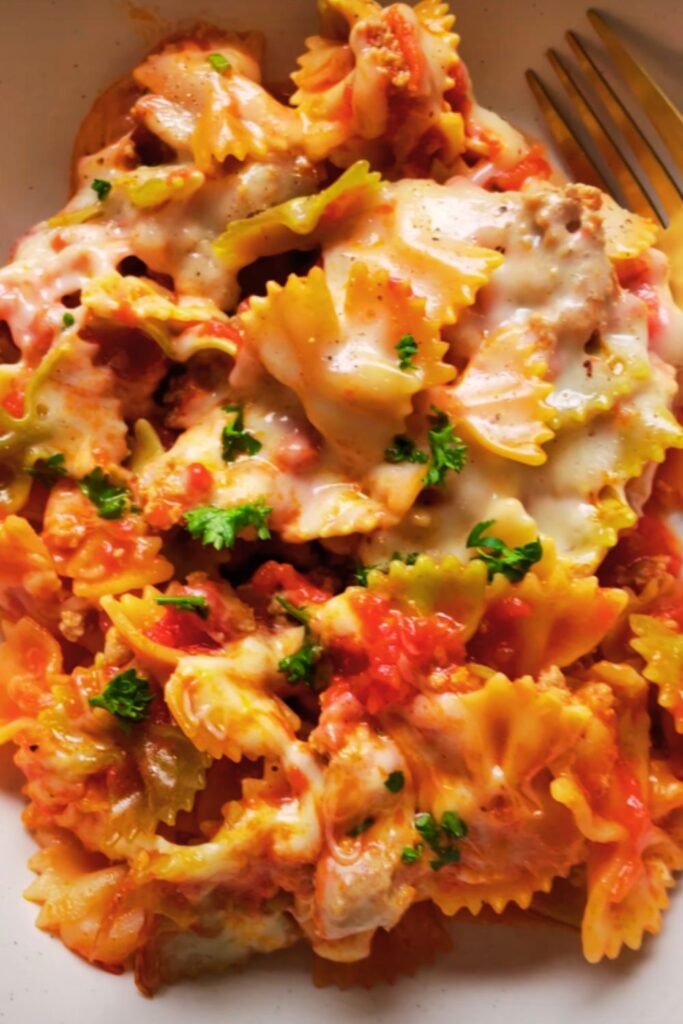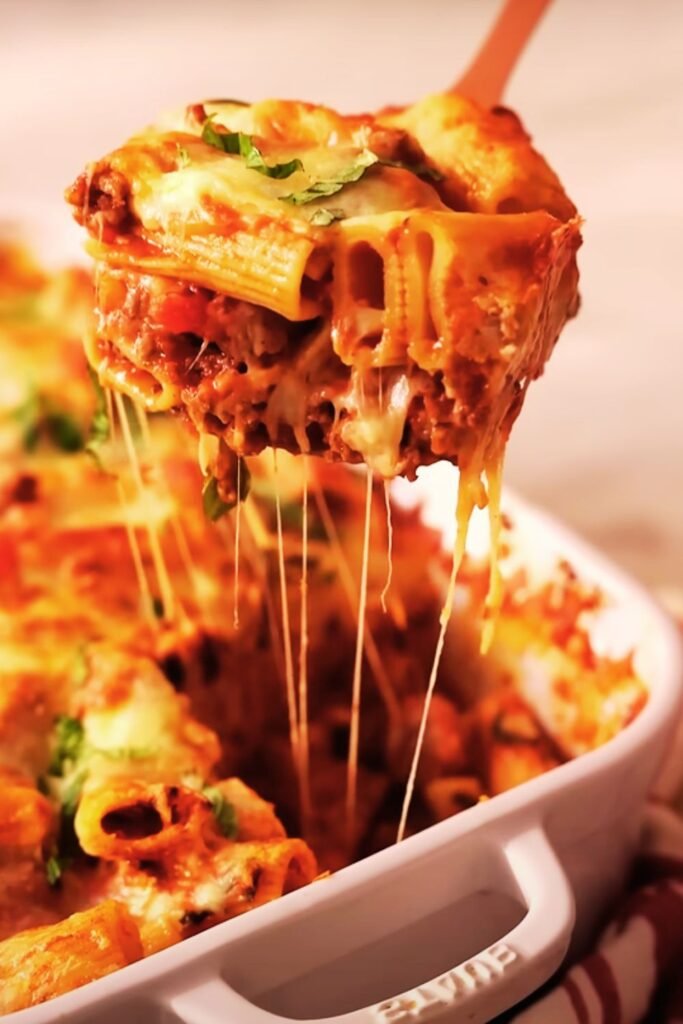There’s something magical about walking into a kitchen filled with the aroma of a bubbling casserole fresh from the oven. Polish pasta casserole, or “zapiekanka makaronowa” as we call it in Poland, represents everything I love about comfort food – it’s hearty, satisfying, and brings people together around the dinner table. This dish has been warming Polish hearts and homes for generations, combining simple ingredients into something truly spectacular.
I’ve been perfecting this recipe for over fifteen years, drawing inspiration from my grandmother’s handwritten notes and countless family gatherings. What makes Polish pasta casserole so special isn’t just its incredible taste, but its versatility and the way it transforms humble ingredients into a meal that feels like a warm hug. Whether you’re feeding a hungry family on a weeknight or preparing for a special occasion, this casserole delivers every single time.
Understanding Polish Pasta Casserole
Polish Pasta Casserole (Zapiekanka Makaronowa): A traditional baked dish combining pasta with various proteins, vegetables, and cheese, typically topped with breadcrumbs and baked until golden brown.
Comfort Food: Food that provides consolation or a feeling of well-being, typically with high carbohydrate content and associated with childhood or home cooking.
Casserole Cooking Method: A slow-cooking technique where ingredients are combined in a covered dish and baked in the oven, allowing flavors to meld together.
The beauty of Polish pasta casserole lies in its adaptability. Unlike many traditional dishes that require exact measurements and techniques, this casserole embraces creativity and personal preferences. I’ve served this dish to countless guests over the years, and each time I make it, I discover new flavor combinations that work beautifully together.
Essential Ingredients and Their Roles
Creating the perfect Polish pasta casserole starts with understanding each ingredient’s purpose in the final dish. I always tell my cooking students that every component plays a crucial role in building layers of flavor and texture.
Base Ingredients Analysis
| Ingredient | Quantity | Purpose | Substitution Options |
|---|---|---|---|
| Pasta (Penne or Rigatoni) | 1 pound | Structural foundation | Fusilli, Shells, Ziti |
| Ground Meat | 1.5 pounds | Primary protein | Turkey, Chicken, Plant-based |
| Onions | 2 large | Flavor base | Shallots, Leeks |
| Mushrooms | 8 oz | Umami depth | Any variety available |
| Tomato Sauce | 2 cups | Moisture and acidity | Crushed tomatoes, Marinara |
| Cheese (Mixed) | 3 cups | Richness and binding | Cheddar, Mozzarella, Polish cheese |
| Breadcrumbs | 1 cup | Textural contrast | Panko, Crushed crackers |
| Butter | 4 tablespoons | Fat for richness | Olive oil, Margarine |
The pasta choice significantly impacts the final dish. I prefer penne or rigatoni because their hollow centers trap the sauce beautifully, creating perfect bites every time. The ridged surfaces also help the cheese adhere better during baking, resulting in that coveted golden-brown top layer we all love.
Seasoning and Flavor Enhancement
| Seasoning | Amount | Flavor Profile | When to Add |
|---|---|---|---|
| Garlic | 4 cloves | Aromatic base | With onions |
| Paprika | 2 teaspoons | Smoky sweetness | With meat |
| Marjoram | 1 teaspoon | Herbal warmth | Mid-cooking |
| Bay Leaves | 2 leaves | Depth and complexity | During simmering |
| Salt | To taste | Flavor enhancement | Throughout process |
| Black Pepper | 1 teaspoon | Heat and spice | Final seasoning |
| Sour Cream | 1 cup | Creamy tanginess | Before baking |
Step-by-Step Cooking Process
My approach to making Polish pasta casserole has evolved over the years, and I’ve refined each step to ensure consistent, delicious results every time. The key is building layers of flavor rather than simply combining ingredients.

Preparation Phase
I always start by gathering all my ingredients and preparing them completely before I begin cooking. This mise en place approach prevents mistakes and ensures smooth cooking flow.
- Dice onions into uniform pieces for even cooking
- Slice mushrooms to medium thickness for optimal texture
- Grate cheese fresh for better melting properties
- Measure all seasonings into small bowls
- Preheat oven to 375°F (190°C)
Building the Foundation
The foundation of any great Polish pasta casserole starts with properly cooked pasta. I cook my pasta to al dente, which means it still has a slight bite when tested. This prevents the pasta from becoming mushy during the baking process.
In my largest pot, I bring salted water to a rolling boil. The water should taste like mild seawater – this seasons the pasta from within. I add the pasta and stir immediately to prevent sticking, then cook according to package directions minus two minutes.
While the pasta cooks, I heat a large skillet over medium-high heat and add butter. Once it foams and subsides, I add the diced onions and cook until they become translucent and slightly golden. This caramelization process adds incredible depth to the final dish.
Protein and Vegetable Layer
After the onions develop their beautiful color, I add minced garlic and cook for just thirty seconds until fragrant. Then comes the ground meat, which I break up with a wooden spoon and cook until no pink remains. The key here is not to stir too frequently – letting the meat develop some browning adds complexity to the flavor profile.
Once the meat is cooked through, I add sliced mushrooms and seasonings. The mushrooms release their moisture, which I allow to cook off completely. This concentration of flavors creates the rich base that makes this casserole so satisfying.
Sauce Integration
Adding the tomato sauce marks a crucial moment in the cooking process. I pour it in slowly, scraping up any browned bits from the bottom of the pan. These fond particles contain concentrated flavors that elevate the entire dish. I let this mixture simmer for about ten minutes, allowing the flavors to meld together beautifully.
The sour cream goes in last, stirred gently to create a creamy, cohesive sauce. I taste and adjust seasonings at this point, ensuring the flavor balance is perfect before assembly.
Assembly and Baking Techniques

Proper assembly makes the difference between a good casserole and an exceptional one. I use a large, buttered baking dish – typically 9×13 inches for this recipe size.
Layering Strategy
| Layer | Components | Purpose |
|---|---|---|
| Bottom | Pasta + half the sauce | Foundation and moisture |
| Middle | Half the cheese mixture | Binding and richness |
| Second | Remaining pasta and sauce | Structure completion |
| Top | Remaining cheese + breadcrumbs | Golden crust formation |
I start by combining the drained pasta with about half of the meat sauce in the baking dish. This ensures every piece of pasta gets coated with flavor. Then I sprinkle half of the cheese mixture over this layer, creating pockets of melted goodness throughout the casserole.
The remaining pasta and sauce go on next, followed by the final cheese layer. I finish with a generous sprinkling of breadcrumbs mixed with a little melted butter. This creates that irresistible golden-brown crust that makes everyone’s mouth water.
Baking Process
I cover the casserole with aluminum foil for the first thirty minutes of baking. This prevents the top from browning too quickly while allowing the interior to heat through completely. After thirty minutes, I remove the foil and continue baking for another fifteen to twenty minutes until the top is golden brown and bubbling around the edges.
The internal temperature should reach 165°F (74°C) for food safety, but more importantly, a knife inserted in the center should come out hot to the touch.
Nutritional Information and Health Benefits
Understanding the nutritional profile of Polish pasta casserole helps me make informed decisions about serving sizes and meal planning. This hearty dish provides substantial nutrition along with its comfort food appeal.
Comprehensive Nutritional Breakdown
| Nutrient | Per Serving (1/8 recipe) | Daily Value % | Health Benefits |
|---|---|---|---|
| Calories | 520 | 26% | Energy provision |
| Protein | 28g | 56% | Muscle maintenance |
| Carbohydrates | 45g | 15% | Energy and fiber |
| Total Fat | 24g | 31% | Essential fatty acids |
| Saturated Fat | 12g | 60% | Flavor and satiety |
| Cholesterol | 85mg | 28% | Cell membrane function |
| Sodium | 890mg | 39% | Electrolyte balance |
| Fiber | 4g | 14% | Digestive health |
| Calcium | 320mg | 24% | Bone health |
| Iron | 3.2mg | 18% | Oxygen transport |
The protein content in this casserole comes primarily from the ground meat and cheese, providing all essential amino acids necessary for muscle maintenance and growth. The combination creates a complete protein profile that’s particularly beneficial for active individuals and growing families.
Variations and Customizations
Over the years, I’ve developed numerous variations of this classic recipe to accommodate different dietary needs and preferences. Each variation maintains the soul of the original while offering something unique.

Meat Variations
The beauty of Polish pasta casserole lies in its adaptability to different proteins. I’ve successfully made versions using ground turkey, chicken, and even a mixture of different meats. Each brings its own character to the dish.
For a lighter version, I substitute ground turkey for beef, reducing the overall fat content while maintaining protein levels. The key is adding extra seasonings to compensate for turkey’s milder flavor profile.
Vegetarian Adaptations
My vegetarian version replaces meat with a combination of mushrooms, lentils, and walnuts. I sauté extra mushrooms until they’re deeply browned, then add cooked green lentils and chopped walnuts. This combination provides protein, texture, and umami flavors that satisfy even dedicated meat-eaters.
Cheese Combinations
| Cheese Type | Flavor Profile | Melting Properties | Best Use |
|---|---|---|---|
| Mozzarella | Mild, creamy | Excellent stretch | Base layer |
| Cheddar | Sharp, tangy | Good melting | Top layer |
| Polish Farmer’s Cheese | Mild, slightly tangy | Moderate melting | Mixed throughout |
| Parmesan | Sharp, nutty | Doesn’t melt smoothly | Finishing touch |
| Gouda | Smoky, rich | Excellent melting | Special occasions |
I often combine three different cheeses for complexity – mozzarella for stretch, cheddar for sharpness, and a touch of Parmesan for depth. This creates layers of flavor that develop beautifully during baking.
Serving Suggestions and Accompaniments
Polish pasta casserole is hearty enough to stand alone as a complete meal, but I love pairing it with complementary sides that enhance the overall dining experience without overwhelming the main dish.
Traditional Polish Accompaniments
- Mizeria (Cucumber Salad): The crisp, refreshing cucumber dressed in sour cream and dill provides a cooling contrast to the rich casserole
- Surówka (Shredded Cabbage Salad): Raw cabbage with carrots and a light vinaigrette cuts through the richness beautifully
- Pickled Vegetables: Traditional Polish pickles add acidity that balances the cheese and meat
- Dark Rye Bread: Hearty bread perfect for soaking up any remaining sauce
Modern Serving Ideas
I’ve found that lighter, fresh accompaniments work wonderfully with this rich casserole. A simple green salad with lemon vinaigrette refreshes the palate between bites. Roasted vegetables like asparagus or Brussels sprouts add color and nutritional balance to the plate.
For family gatherings, I often serve the casserole buffet-style with several small sides, allowing everyone to customize their plate according to their preferences.
Storage and Reheating Guidelines
Proper storage ensures that leftover Polish pasta casserole tastes almost as good as when it’s fresh from the oven. I’ve perfected these techniques through years of meal prepping and entertaining.
Storage Methods
| Storage Method | Duration | Temperature | Best Practice |
|---|---|---|---|
| Refrigerator | 3-4 days | 40°F (4°C) | Cover tightly with foil |
| Freezer (whole) | 3 months | 0°F (-18°C) | Wrap in plastic + foil |
| Freezer (portions) | 3 months | 0°F (-18°C) | Individual containers |
| Room Temperature | 2 hours max | Below 90°F | Food safety concern |
I always let the casserole cool completely before refrigerating to prevent condensation, which can make the top layer soggy. When freezing, I portion the casserole into family-sized or individual servings for convenient reheating later.
Reheating Techniques
For best results, I thaw frozen casserole overnight in the refrigerator before reheating. I cover it with foil and reheat at 350°F (175°C) for about 25-30 minutes until heated through. For individual portions, the microwave works well – I use 50% power to ensure even heating without overcooking the edges.
Troubleshooting Common Issues
Even experienced cooks encounter challenges when making casseroles. I’ve compiled solutions to the most common problems I’ve encountered over the years.
Texture Problems and Solutions
| Problem | Cause | Prevention | Fix |
|---|---|---|---|
| Mushy pasta | Overcooked initially | Cook al dente | Can’t fix, prevent next time |
| Dry casserole | Insufficient sauce | Add more liquid | Cover with foil, add broth |
| Watery result | Too much moisture | Drain vegetables well | Uncover while baking |
| Burnt top | Temperature too high | Lower heat, cover | Scrape off burnt layer |
| Uneven heating | Dish too deep | Use shallower pan | Stir halfway through |
The most common mistake I see is overcooking the pasta initially. Remember, it continues cooking in the oven, so undercooking slightly prevents mushiness in the final dish.
Cultural Significance and Family Traditions
Polish pasta casserole represents more than just a meal in my family – it’s a bridge between generations and a keeper of memories. My grandmother taught me this recipe during long afternoons in her kitchen, sharing stories of resourcefulness during difficult times when simple ingredients had to stretch to feed large families.
This dish embodies the Polish spirit of hospitality and abundance. In Poland, we have a saying: “Guest in the house, God in the house,” and casseroles like this one allowed families to welcome unexpected visitors with confidence, knowing they could quickly expand the meal to accommodate more people.
I’ve served this casserole at countless family gatherings, potluck dinners, and neighborhood celebrations. Each time, I’m reminded of its power to bring people together and create new memories around the dinner table.
Questions and Answers
Q: Can I prepare Polish pasta casserole ahead of time?
Yes, absolutely! I often assemble the entire casserole up to 24 hours before baking. Simply cover it tightly with plastic wrap and refrigerate. When ready to bake, remove from refrigerator 30 minutes before cooking to take the chill off, then bake as directed, adding 5-10 extra minutes to account for the cold start.
Q: What’s the best pasta shape for this casserole?
I prefer penne or rigatoni because their hollow centers and ridged surfaces hold onto the sauce beautifully. However, shells, fusilli, or ziti work well too. Avoid long pasta like spaghetti or angel hair, as they don’t distribute evenly in casseroles and can become clumpy.
Q: Can I make this casserole gluten-free?
Definitely! Simply substitute your favorite gluten-free pasta and use gluten-free breadcrumbs for the topping. I’ve had great success with rice-based and chickpea pasta varieties. The cooking time might vary slightly, so check the pasta package directions and adjust accordingly.
Q: How do I know when the casserole is fully cooked?
The casserole is done when the internal temperature reaches 165°F (74°C) and the top is golden brown with bubbling edges. A knife inserted in the center should come out hot to the touch. The surface should look set, not liquidy or jiggly.
Q: Can I freeze individual portions of this casserole?
Yes, this freezes beautifully in individual portions! I use freezer-safe containers and label them with contents and date. Frozen portions keep for up to three months. Thaw overnight in the refrigerator and reheat in the microwave or oven until heated through.
Q: What can I substitute for sour cream in this recipe?
Greek yogurt works wonderfully as a substitute, providing similar tanginess and creaminess with added protein. Cream cheese, softened and thinned with a little milk, also works well. For dairy-free options, try cashew cream or a plant-based sour cream alternative.
Q: How can I make this casserole spicier?
I love adding heat to this dish! Try incorporating diced jalapeños with the onions, adding a teaspoon of hot paprika, or mixing in some crushed red pepper flakes with the seasonings. For more complex heat, a tablespoon of harissa or chipotle peppers in adobo sauce works beautifully.
Q: Why does my casserole sometimes turn out watery?
Excess moisture usually comes from not draining the pasta properly or using vegetables with high water content without cooking off the moisture first. Always drain pasta thoroughly and cook mushrooms until their liquid evaporates. If using frozen vegetables, thaw and drain them completely before adding to the casserole.
Q: Can I add vegetables to this recipe?
Absolutely! I often add bell peppers, zucchini, or spinach to boost nutrition. Sauté harder vegetables like peppers with the onions, and add leafy greens like spinach at the very end to prevent overcooking. Frozen vegetables should be thawed and drained before adding.
Q: How do I prevent the cheese from becoming rubbery?
Use freshly grated cheese rather than pre-shredded, as it melts more smoothly. Don’t overbake the casserole, and avoid using only hard cheeses like Parmesan. A combination of softer melting cheeses like mozzarella and cheddar with a small amount of hard cheese creates the best texture.
This Polish pasta casserole has been my go-to comfort food recipe for countless occasions, from busy weeknight dinners to special family celebrations. Its versatility, make-ahead convenience, and ability to feed a crowd make it an invaluable addition to any cook’s repertoire. Every time I make it, I’m reminded why some recipes become family treasures – they nourish not just our bodies, but our souls and our connections to one another.